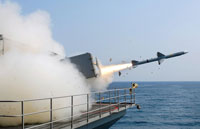
|
||
|
SEA SPARROW/EVOLVED SEA SPARROW (ESSM) |
|||||||||||||||||||||
|
Sea Sparrow was developed from the AIM-7 Sparrow air-to-air missile as a lightweight "point defence" weapon that could be retrofitted to existing ships, often in place of existing gun-based anti-aircraft weapons.
The primary development issues were changes to the seekers to allow them to operate with shipboard radars, and the new Mark 25 trainable launcher system, based on the ASROC launcher, to align the seeker head with the target before launch.
Combined
with a Mark 115 manned fire control director it was known as the Basic
Point Defence Surface Missile System (BPDSMS) or just BPDMS.
Additionally the engine is optimized for flight time, as opposed to fast acceleration, which makes sense when launched from an aircraft moving at high speed at a target at long range. In the surface-to-air role, however, one would rather have very high acceleration in order to allow it to intercept sea-skimming targets as soon as possible.
Furthermore, the Sea Sparrow possesses a shorter range than its
air-to-air counterpart. Some estimates indicate that it may be
effective only to 10 nm, about one quarter of the range of the AIM-7
Sparrow.
The RIM-162 Evolved Sea Sparrow Missile (ESSM) is a development of the RIM-7 Sea Sparrow missile used to protect ships from attacking missiles and aircraft. ESSM is designed to counter supersonic manoeuvring anti-ship missiles.
Compared to the Sea Sparrow, ESSM has a larger, more
powerful rocket motor for increased range and agility, as well as
upgraded aerodynamics using strakes and skid-to-turn. In addition,
ESSM takes advantage of the latest missile guidance technology, with
different versions for Aegis/SPY-1, Sewaco/APAR, and traditional
target illumination all-the-way. ESSM also has the ability to be
"quad-packed" in the Mk 41 VLS system, allowing four times the number
of Sea Sparrow to be carried.
|
|||||||||||||||||||||
